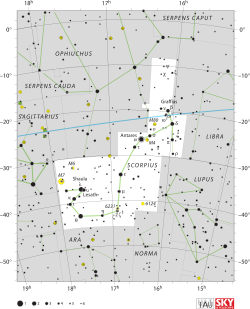HD 145377
| HD 145377 | |
 | |
| Observationsdata Epok: J2000.0 | |
|---|---|
| Stjärnbild | Skorpionen |
| Rektascension | 16t 11m 36,44650s[1] |
| Deklination | -27° 04′ 41,4338″[1] |
| Skenbar magnitud () | +8,10 (V)[2] |
| Stjärntyp | |
| Spektraltyp | G3 V[3] |
| B–V | +0,63[2] |
| Astrometri | |
| Radialhastighet () | +11,610 ± 0,0011[4] km/s |
| Egenrörelse (µ) | RA: +21,786[1] mas/år Dek.: +13,039[1] mas/år |
| Parallax () | 18,6669 ± 0,0498[1] |
| Avstånd | 174,77 ± 0,5 lå (53,6 ± 0,1 pc) |
| Absolut magnitud () | 4,31[5] |
| Detaljer | |
| Massa | 1,129 ± 0,022[4] M☉ |
| Radie | 1,05 ± 0,02[6] eller 1,12 ± 0,03[7] R☉ |
| Luminositet | 1,56 ± 0,17[5] eller 1,43 ± 0,04[7] L☉ |
| Temperatur | 6 046 ± 15[5] K |
| Metallicitet | 0,12 ± 0,01 (Fe/H)[5] dex |
| Vinkelhastighet | 3,85[5] km/s |
| Ålder | 0,857 ± 0,732[8] eller 2,90 ± 1,20[7] miljarder år |
| Andra beteckningar | |
| CD−26°11249, HD 145377, HIP 79346, SAO 184208, PPM 265238, GSC 06801-00585, 2MASS J16113644-2704414 [9] | |
HD 145377 är en ensam stjärna belägen i den mellersta delen av stjärnbilden Skorpionen. Den har en skenbar magnitud av ca 8,10[2] och kräver åtminstone en stark handkikare eller ett mindre teleskop för att kunna observeras. Baserat på parallax enligt Gaia Data Release 2 på ca 18,7[1] mas, beräknas den befinna sig på ett avstånd på ca 175 ljusår (ca 54 parsek) från solen. Den rör sig bort från solen med en heliocentrisk radialhastighet på ca 12 km/s.[4]
Egenskaper
[redigera | redigera wikitext]HD 145377 är en gul till vit stjärna i huvudserien av spektralklass G3 V.[3] Den har en massa som är ca 1,1[8] solmassor, en radie som är ca 1,1[6] solradier och har ca 1,5 gånger solens utstrålning av energi[5] från dess fotosfär vid en effektiv temperatur av ca 6 000 K.[5]
Planetsystem
[redigera | redigera wikitext]I oktober 2008 rapporterades en exoplanet, HD 145377 b, kretsa kring stjärnan. Detta objekt upptäcktes med hjälp av metoden för mätning av radiell hastighet som genomfördes med HARPS-spektrograf. Den är en Superjupiter i en excentrisk bana med en omloppsperiod av 104 dygn.[5]
(AE) |
(d) |
|||||
|---|---|---|---|---|---|---|
Se även
[redigera | redigera wikitext]Referenser
[redigera | redigera wikitext]- Den här artikeln är helt eller delvis baserad på material från engelskspråkiga Wikipedia, HD 145377, 7 januari 2021.
Noter
[redigera | redigera wikitext]- ^ [a b c d e f] Brown, A. G. A.; et al. (Gaia collaboration) (August 2018). "Gaia Data Release 2: Summary of the contents and survey properties". Astronomy & Astrophysics. 616. A1. arXiv:1804.09365. Bibcode:2018A&A...616A...1G. doi:10.1051/0004-6361/201833051. Gaia DR2 record for this source at VizieR.
- ^ [a b c] Høg, E.; et al. (2000). The Tycho-2 catalogue of the 2.5 million brightest stars. Astronomy and Astrophysics. 355. pp. L27. Bibcode:2000A&A...355L..27H. doi:10.1888/0333750888/2862. ISBN 978-0333750889.
- ^ [a b] Houk, Nancy (1979). Michigan catalogue of two-dimensional spectral types for the HD stars. 3. Ann Arbor, Michigan: Dept. of Astronomy, University of Michigan. Bibcode:1982mcts.book.....H.
- ^ [a b c] Soubiran, C.; et al. (2018). "Gaia Data Release 2. The catalogue of radial velocity standard stars". Astronomy and Astrophysics. 616: A7. arXiv:1804.09370. Bibcode:2018A&A...616A...7S. doi:10.1051/0004-6361/201832795.
- ^ [a b c d e f g h i] Moutou, C.; et al. (2009). "The HARPS search for southern extra-solar planets XVII. Six long-period giant planets around BD -17 0063, HD 20868, HD 73267, HD 131664, HD 145377, HD 153950". Astronomy and Astrophysics. 496 (2): 513–519. arXiv:0810.4662. Bibcode:2009A&A...496..513M. doi:10.1051/0004-6361:200810941.
- ^ [a b] Stassun, Keivan G.; et al. (March 2017). "Accurate Empirical Radii and Masses of Planets and Their Host Stars with Gaia Parallaxes". The Astronomical Journal. 153 (3): 20. arXiv:1609.04389. Bibcode:2017AJ....153..136S. doi:10.3847/1538-3881/aa5df3. S2CID 119219062. 136.
- ^ [a b c] Bonfanti, A.; Ortolani, S.; Nascimbeni, V. (2016). "Age consistency between exoplanet hosts and field stars". Astronomy & Astrophysics. 585: A5, 14 pp. arXiv:1511.01744. Bibcode:2016A&A...585A...5B. doi:10.1051/0004-6361/201527297. S2CID 53971692.
- ^ [a b] Delgado Mena, E.; et al. (April 2019). "Abundance to age ratios in the HARPS-GTO sample with Gaia DR2. Chemical clocks for a range of [Fe/H]". Astronomy & Astrophysics. 624: 24. arXiv:1902.02127. Bibcode:2019A&A...624A..78D. doi:10.1051/0004-6361/201834783. A78.
- ^ "HD 145377". SIMBAD. Centre de données astronomiques de Strasbourg. Retrieved 2015-12-02.
Externa länkar
[redigera | redigera wikitext]Text is available under the CC BY-SA 4.0 license; additional terms may apply.
Images, videos and audio are available under their respective licenses.





